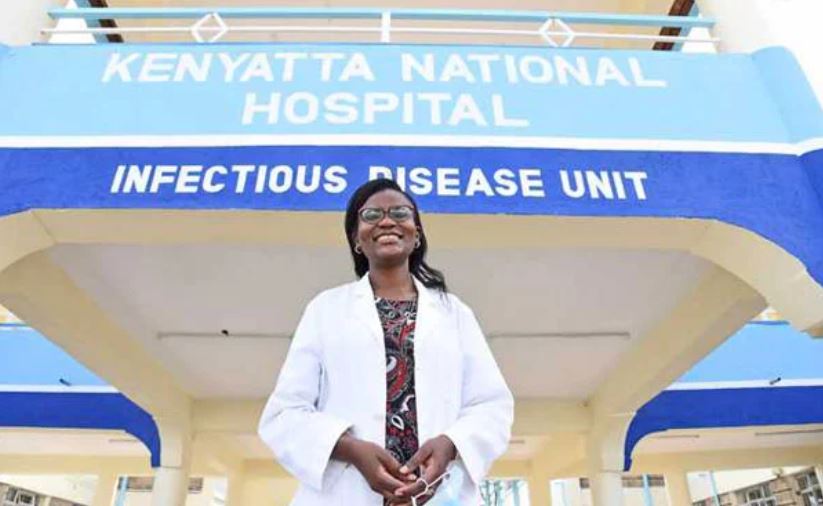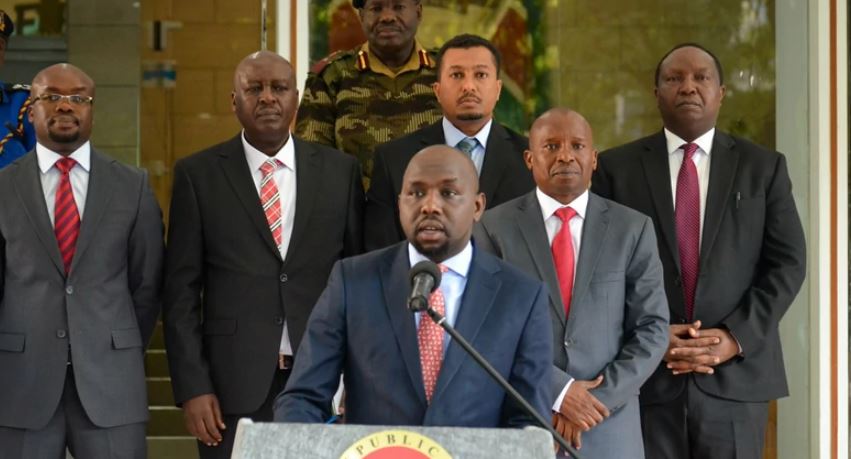 Kenya has joined the international bandwagon in the search for a cure for Covid-19, with plans for clinical trials of three drugs in the East African nation.
Kenya has joined the international bandwagon in the search for a cure for Covid-19, with plans for clinical trials of three drugs in the East African nation.
Kenyan researchers are seeking approvals to conduct the trials to determine if Remdesivir, an antiretroviral drug that was recently approved by the United States Food and Drug Administration for emergency treatment of Covid-19, Lopinavir/ritonavir, also used on HIV patients, and anti-malaria drug hydroxychloroquine can effectively treat Covid-19 patients in Kenya.
Principal investigator in the study, Dr Loice Achieng Ombajo, who heads the Infectious Disease Unit at Kenyatta National Hospital, spoke in detail about the trials and the coronavirus pandemic in Kenya in an interview with Nation.
Below are some excerpts:
Q: What has it been like for your unit since the first case of coronavirus was confirmed in Kenya?
The first case was announced on March 13, but prior to that, we had had a number of people coming in for screening. These were people who had travelled into the country or who had some symptoms, or they had been picked up at the airport as having a fever.
Then comes March 13 and from that point, we had to deal with the issues of getting the healthcare team together, to be prepared to manage the patient, and at the same time, prepare for more patients.
I was also asked to join the National Task Force for Covid-19 response at the Ministry of Health. This involved several meetings with various groups of stakeholders: Thinking around: How do we take care of patients? What does it take to take care of patients? Do we have facilities? Do we have healthcare workers? Are these healthcare workers trained? Do we have the personal protective equipment? Are we able to test?
At the same time, there were other teams thinking about: How the laboratory is set up; who is going to collect samples? How are the samples going to be transported? Which lab will they be transported to? What is the capacity of various labs to test? How do we get more test kits?
There was a team looking at how to engage the community and one looking at what was happening in the global arena and what that meant for us. At that time many countries in Europe and the US were having an explosion of cases so the issue was; ‘where will we be in a short while?’ which means we also had to try and crunch some numbers, put some models together to say where we will be in a week’s time, in two weeks’ time and what will it take us to prepare for two weeks’ time or what will it take us to minimise the cases so that we buy time to prepare for a larger number of cases. There was modelling, and out of that there was a group that was also asked to give some advisories to the government around what do we needed, from a healthcare perspective to reduce the number of cases that we see, and to ensure the cases we got would be well taken care of.
That involved talking about closure of schools, reducing public gatherings, restricting international travel and, as time went on and more cases evolved, it was about mapping the country and saying which areas would have the highest risk for severe disease and how to restrict movement.
On the other hand, we have to think about research.
This involves writing protocols and trying to get ethics approval so that you can actually conduct some studies.
The other thing that I had to lead was writing guidelines for management of patients.
How would you categorise the patients you’ve see so far, starting with the young woman who was the first confirmed case.
I’ll talk about the patients we’ve had at KNH, and the unit at Mbagathi. Some have absolutely no symptoms. They were tested either because they were in quarantine having travelled into the country recently or because they had contacted a positive case.
Then you have those who have mild symptoms. They may have some cough, maybe fever. They’re not having trouble breathing, they’re not complaining too much. For some, it’s just a mild sore throat, maybe a running nose, occasional chest pain. Otherwise, they’re just okay. Then, there are some who get a little sicker. They’re coughing a lot more, have more difficulty breathing, and the amount of oxygen in their blood is not as high as it should be. Those are the ones you’d call moderate cases.
Then you have the ones that have severe disease, which means they are having significant trouble breathing. You may need to support their breathing and other body organs may also begin to fail.
The pattern you describe informs how Kenyans behave. What percentage would the patients with severe illness form?
That’s an important question: How should that inform behaviour? Because people may think “Oh well you know everybody’s asymptomatic anyway, so why should I bother?” But you can’t predict who will get severe disease. I can’t look at you and say “if I expose you to Corona, you’re fine you won’t get severe disease.” You really can’t tell that from the beginning.
From what we’ve seen so far, at time of presentation about 70 per cent are asymptomatic and 30 per cent are symptomatic. Just about five per cent will go on to have severe disease and about four out of 100 of those people who had Covid have died.
This is quite high, isn’t it?
It is high. If you had 1,000 people, that would be 40 people. If you had 100,000 people that would be 400 people. Everybody has to be careful because you can’t predict who will get asymptomatic or severe disease and three to four per cent will die. That’s one point of concern.
The other worry is that if 47 million Kenyans get sick now and 20 per cent of them get symptoms: that’s more than eight million Kenyans. If a percentage of those were to get severe disease, that’s again a few million Kenyans. We don’t have the capacity to take care of a few million critically ill people at the same time; which means some people may die, not so much because of disease, but because they couldn’t get adequate care. That’s why you’ve heard this concept of flattening the curve. It means spreading the cases to a level that can be handled with the healthcare capacity that we have.
Just to mention that majority of people will probably get sick at some point because respiratory illnesses tend to spread in the community. So, a year from now, most of us would probably have got Covid. We may not have known we had it, but the problem is if millions get sick at the same time.
Of the cases that you’ve handled, how many required to be managed in ICU? How many needed a ventilator?
Most of the ones in whom we diagnosed Covid earl did not require ICU. We’ve had a few unfortunate cases; one of a child who rapidly deteriorated and died. More recently we also had a gentleman who came in and died within a few hours. Which means that some people may present later; probably they had been unwell for a few days at home before they came, and they only came because they were feeling really sick, and at that point it means that even before we know that this person has Covid, they’ve already passed on.
So, you haven’t had one that has been very sick over long time?
Not over a long time. Remember this is an acute respiratory illness. It means it would present with a few days of illness. But my colleagues from the other hospitals have had patients who they had to keep in the ICU for quite a few days. Some made it out of ICU, some did not and we know that for the ones who actually require ventilation, many of them don’t make it out of ICU; and that’s a feature that’s been seen globally. It goes back to when you’re talking about case management. I know Kenyans are talking about ventilators. It is not the magic! The magic is in identifying early, offering supportive care, offering oxygen where that is necessary and trying to reduce the number of people who go on to require ventilation.
Is it true that all the 14 Kenyans we’ve lost to Covid-19 so far (by April 30) had underlying medical conditions?
Many of them did. I guess the most common were diabetes, heart disease or other chronic lung diseases. We know that patients who have underlying conditions or what we call ‘co-morbidities’ are at higher risk for developing severe disease; and older people as well. Most of the patients we’ve lost have been above the age of 60 and this underlies the reason there is this restriction from travelling out of Nairobi and out of the coastal counties. It was the recognition that most of our old people live outside of Nairobi.
Please break down the numbers.
Of the 14 mortalities we’ve had, seven were aged 60 years and above, while four were in the age range of 50 to 59, and again they did have co-morbidities. The concern is when we have these younger ones. We had two in the age range of 30 to 39 and two in the range of 40 to 49, and one child was six years old. The six-year-old child did have other underlying conditions. For the 40 to 49 age-group, there were certain things like smoking or underlying lung disease. What we know from our colleagues as well, is that most of these patients did have some underlying condition.
Have there been any patients who just came in, who were neither from contact tracing or quarantine centres?
Yes. Actually right now for example, if you go to Mbagathi — because it’s one of the testing sites — you will have people who come in and say, “I’ve been coughing, I think I had contact”, or who come on their own, not because they were traced by the contact-tracing team or because they travelled. So people are beginning to get a little more aware, and are coming when they have a cough or fever, or any symptoms.
Is it possible to see a pattern of community infections from these walk-ins?
For example, there is a patient who came to us for other reasons, but on screening, was found to have fever and cough, and was tested. They were quite sick at the time and on testing they were found to have Covid. So we went back to look for their contacts and all their immediate contacts were positive for Covid. So, you see when that begins to happen, then you realise that there may be spread that’s going on in the communities; hence the reason people should stay home and avoid public gatherings.
What does this disease do to the body?
It’s a respiratory disease, which means it will infect what we call the respiratory epithelium — the lining of the respiratory tract, from the back of the nose, the throat, the airways, all the way to the lungs. Once it goes and affects the lungs, the body mounts what you call an inflammatory response. Usually, if you have anything foreign in your body, your body responds to it. But sometimes this inflammatory response is very excessive and there’s damage to the cells by the virus, as well as damage by the body’s own inflammatory response. So the lungs begin filling with cells. They begin to be filled with some fibrous tissue as well and that reduces the amount of space available for oxygen exchange to happen. When you have limited oxygen exchange, this begins to affect other organs in the body as well.
Are you administering any treatment on the patients? If so, which drugs are you using?
Let me start by saying that at this point the national strategy should be containment. This means anyone confirmed to have the virus shouldn’t be out in the community, they should be in a facility. The facility at this point has been the hospitals. Hopefully, that will change, and we’ll have facilities outside of a hospital that can take care of people that are asymptomatic.
So those who are asymptomatic don’t need any treatment. We just keep them there, keep them warm and feed them and wait for them to be negative so that they can go back to their families.
For those with mild symptoms, maybe throat irritation, cough or fever, we’ll give them something to reduce the fever, to reduce the blockage of the nose and throat irritation.
There are some who are more severely ill and maybe have very severe pneumonia. Those ones may end up receiving treatment for other infections that could occur concurrently with COVID.
Is there hope for a treatment soon?
There are a number of studies going on, all around the world, to try and find if there is a particular drug. Some of the ones that have been mentioned are hydroxychloroquine or chloroquine, some antiretrovirals for HIV treatment. Remdesivir (approved by the US is an antiviral drug which was previously tried for Ebola. It didn’t work too well with Ebola but it does have antiviral activity against coronaviruses. Some studies show that they work, some studies show that they don’t work so well.
So at this point, we’re still in that stage where you can’t tell what actually works. What we’re hoping to do in the country is to do something called a clinical trial. In a clinical trial, like the one we propose to do after we get all the approvals, you take many patients and randomly allocate them to one treatment or another. There’s an equal chance of ending up with any of these and we’ll give you that treatment and observe your response.
We are joining an international study, and we’ll be conducting that at different centres in the country to help determine if there is any drug that would work.
I know clinical trials have a bad name, but believe me every drug that we use is availed to us because a clinical trial was done.
I’m the principal investigator in the country for one of the clinical trials. It is an international trial. There’s a protocol that every country is adapting. We get things that are specific to population that we need to think about We write an addendum for Kenya with this protocol then we submit to the ethics committee. There are multiple ethics committees. For this one we submitted it to one at the University of Nairobi and KNH; some of our colleagues submitted to one at Moi University. The ethics committee, made up of experts in various medical areas, review the submission to see whether the science is correct, and the ethics are correct. No one is coerced. You protect everyone who goes into this study you don’t expose people’s details.
Once they give us approval, and give us a favourable review, we then go to the Poisons and Pharmacists Board and present that with all the details of every single drug.
Once the board gives approval, the next stop is the National Council of Science, Technology and Innovation (NACOSTI), which also reviews your submission and gives you approval to run the study in the country.
Then you embark on community engagement and participants have to give “informed consent”.
You have to sit down with someone who might be interested or has a disease of interest and say; “we’re doing this study, these are these drugs were testing, this is why we are testing them, this is how we will protect you. If you get sick we have insurance that will take care of you. Do you agree to participate?” and they sign a consent. That is when we can conduct trial. It’s a very vigorous process.
At what stage is the Kenyan trial?
We have obtained ethics approval, we had submitted to the Poisons and Pharmacies Board, but the members came back to with some comments, we’ve this morning had a meeting with them. We are responding to all those comments. We’ll submit it back to them.
Once we have that approval, we will go to NACOSTI. It may be a few weeks before we can start.
Which drugs will you be using for the Kenyan trial?
The trial will look at Remdesivir, hydroxychloroquine, and Lopinavir/ritonavir, the HIV drug.






